

By Loretta McCarthy, Managing Partner, Golden Seeds
February 13, 2020
For the first time ever, we have five generations in the workplace, ranging in age from 18 to 85 or more. This generational clash can lead to miscommunication and misunderstanding, but it also presents opportunities. To survive and thrive, we must adapt to the changing workplace. Though humans are hardwired to resist change, individuals and companies can learn to adapt and turn the differences between generations into fuel for innovation, creativity and growth.
That was the message from Dr. Joanna Massey, an experienced C-suite communications executive and Board Director specializing in brand management and organizational culture. She is also a corporate speaker and author of the upcoming book, “Culture Shock: Surviving Five Generations in One Workplace” and she gave a sneak peek at the contents of the book to Golden Seeds members at a recent event.
The age range in today’s workplace is unprecedented, because people are living and working longer, so Gen X, Baby Boomer and Silent Generation workers are all still in the workforce. At the same time, young employees are entering the job market in huge numbers. Millennials, who currently range in age from 24 to 39, are the single-largest segment in the workforce today. Generation Z — ages 10 to 23 years old — are just starting to enter the workforce, widening the workforce’s age range even more.
Younger employees are transforming the workplace, affecting levels of change not seen since the hippie counterculture of the 1960s and 1970s. Dr. Massey’s overall message was that different perspectives on life and work between younger and older employees can lead to miscommunication and misunderstanding, but there are solutions.
Members of each age group have had different experiences that shaped their attitudes and behaviors. With each generation, we see a rise in college graduates, working women and liberal political views, and a decline in the percentage who are Caucasian, Christian and married at a young age. In other words, the U.S. population is becoming better educated and more diverse in race, ethnicity and gender identification, as well as religious and political beliefs.
Often, we describe generations with broad generalizations that are informative, though not universally true of everyone:
● The Silent Generation, born from 1928–1945, has a reputation for conformity and civic-mindedness.
● The Baby Boomers, born from 1946–1964, identify themselves by what they do for a living and are goal-driven, disciplined and competitive.
● Generation X, born from 1965–1980, is one of the smallest generations. Nicknamed America’s middle child, because they are sandwiched between two larger generations — the Baby Boomers and Millennials — Gen Xers are known for being flexible. They can adapt to changes ushered in by Millennials and Gen Z, while also acting as a bridge between the oldest and youngest employees.
● Generation Y (better known as Millennials), born from 1981–1996, are the largest generation in the workplace. They expect to move up quickly, but they sometimes find themselves stuck in mid-tier jobs because Boomers aren’t retiring. Older generations have criticized them for “lacking drive,” but Dr. Massey encourages people to reframe their thinking around that moniker. Millennials don’t lack drive; their parents taught them to seek a healthy work/life balance, so the older generations need to understand that they taught these young adults to have different priorities.
● Generation Z, born from 1997–2010, is the largest generation in U.S. and the most diverse. In addition, they have only known a world that is digitally connected, and many are addicted to technology and social media. They’re extremely entrepreneurial.
The major differences among these age groups can lead to misunderstandings. Both sides in an argument may have valid points but view things through different lenses. This is why Dr. Massey says it’s helpful to consider the generational background when negotiating conflict in the workplace. It’s also important for managers to avoid overcorrecting for minor issues.
The solution is not to assign blame, but to change the way we view each other. Change isn’t easy because the brain is hardwired to resist it. But thanks to neuroplasticity, the brain is also capable of learning, which means we can retrain ourselves to react differently.
When seeking to understand someone else, apply the generational lens. What was going on in the world when they were growing up and what lessons were they taught when they entered the workforce? This will have a lot to do with their opinions about work today.
Businesses can learn from organizations that are successfully integrating younger generations into a traditional workplace. Here are some tips based on their experiences:
● Focus on workplace well-being more than material benefits.
● Engage employees by providing meaningful opportunities on key projects. Workplace mobility and professional growth will reduce job hopping.
● Groom younger employees for leadership roles by giving them responsibility to suit their high levels of education and training.
● Allow flexible working conditions such as flex time, working at home and parental leave. Employees will be more focused and productive when not worried about their personal life.
● Make sure you have the most updated technology systems.
● Communicate clearly and often because transparency is key. Share as much as you can even if it’s not a lot.
● Promote reverse mentoring. Have younger employees help older ones with technology and youth culture. It ensures younger employees are valued and older employees continue to learn.
● Be fair about compensation. Employees are aware of pay scales as that information is often available online.
● Be intentional about diversity and inclusion.
Today’s workplace is vastly different, and in some ways much more challenging, than it was decades ago. But if we approach those challenges with an open mind and constructive attitude, we can make the workplace better than ever.
Dr. Massey is President & CEO of JDMA Inc., a communications consulting firm that advises clients on managing global brand reputation with an emphasis on communicating externally and internally with Millennial and Gen Z employees, consumers and investors.